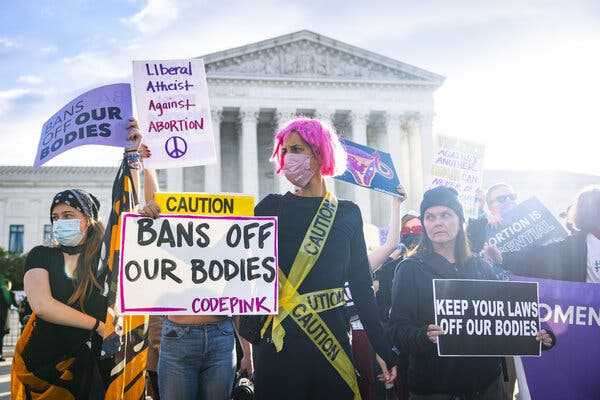In dissent, the three liberal justices said the majority, by allowing a time-consuming legal detour, had created “a disaster for the rule of law.”

Demonstrators outside the Supreme Court last month. The majority gave no reasons for its ruling on Thursday.
WASHINGTON — The Supreme Court on Thursday rejected a request from abortion providers in Texas that a federal judge be allowed to take prompt action on their challenge to a state law that bans most abortions after six weeks. The practical effect of the order, the three liberal justices wrote in dissent, was to let the law stay in place indefinitely.
“This case is a disaster for the rule of law and a grave disservice to women in Texas, who have a right to control their own bodies,” Justice Sonia Sotomayor wrote in dissent.
The majority gave no reasons for its ruling, which followed a decision last month allowing the providers to sue at least some state officials to try to block or limit the law. That victory was an empty one, the dissenting justices wrote on Thursday, because the United States Court of Appeals for the Fifth Circuit, in New Orleans, refused to return the case to the trial judge and instead sent it on a legal detour to a state court.
“It has been over four months since Texas Senate Bill 8 took effect,” Justice Sotomayor wrote. “The law immediately devastated access to abortion care in Texas through a complicated private bounty-hunter scheme that violates nearly 50 years of this court’s precedents.”
“Today, for the fourth time, this court declines to protect pregnant Texans from egregious violations of their constitutional rights,” she wrote, referring to a series of rulings starting with one in September that let the law go into effect notwithstanding Supreme Court precedents that bar states from banning abortions before fetal viability, which is ordinarily around 23 weeks.
“One month after directing that the petitioners’ suit could proceed in part, the court countenances yet another violation of its own commands,” Justice Sotomayor wrote. “Instead of stopping a Fifth Circuit panel from indulging Texas’ newest delay tactics, the court allows the state yet again to extend the deprivation of the federal constitutional rights of its citizens through procedural manipulation.”
Rather than sending the case back to the trial court, which was likely to enter an injunction, the Fifth Circuit asked the Texas Supreme Court to rule on whether the state officials specified in the U.S. Supreme Court’s decision last month have the power to enforce the abortion law.
In a second dissent, Justice Stephen G. Breyer said the appeals court’s action amounted to defiance of his court’s December ruling. “The court of appeals,” he wrote, “ignored our judgment.”
Justices Breyer and Sotomayor joined each other’s dissents, and Justice Elena Kagan joined both.
Nancy Northup, the president of the Center for Reproductive Rights, which represents the abortion providers, said the Supreme Court “is allowing the state of Texas to deprive people of a constitutional right.”
The Texas law has novel features.
Usually, a lawsuit seeking to block a law because it is unconstitutional would name state officials as defendants. However, the Texas law, which makes no exceptions for pregnancies resulting from incest or rape, bars most state officials from enforcing it and instead deputizes private individuals to sue anyone who performs an abortion or “aids and abets” it.
The patient may not be sued, but doctors, staff members at clinics, counselors, people who help pay for the procedure and even an Uber driver taking a patient to an abortion clinic are all potential defendants. Plaintiffs — who do not need to live in Texas, have any connection to the abortion or show any injury from it — are entitled to $10,000 and their legal fees recovered if they win. Prevailing defendants are not entitled to legal fees.
“This structure,” Justice Sotomayor wrote, “was designed to make it more complicated for courts to enjoin the law’s enforcement on a statewide basis.”
In December, though, the Supreme Court allowed suits against state licensing officials like the executive director of the Texas Medical Board, who are authorized to take disciplinary actions against abortion providers who violate the Texas law.
The State of Abortion in the U.S.
Card 1 of 5
Abortion at the Supreme Court. The justices’ upcoming ruling on a Mississippi law could dramatically change abortion access in the U.S., including possibly overturning the landmark Roe v. Wade decision, which established a constitutional right to abortion.
If Roe v. Wade is overturned. Abortion would remain legal in more than half of states, but not in a wide swath of the Midwest and the South. Legislatures in 22 states would almost certainly move to ban or substantially restrict access to abortion.
Who gets abortions in America? The portrait of abortion has changed with society. Today, teenagers are having far fewer abortions. The typical patient is most likely already a mother, poor, unmarried, in her late 20s, has some college education and is very early in pregnancy.
The politics are complicated. Americans are not as neatly divided on abortion as politicians and activists. Overall, 26 percent of voters hold a different view on abortion than the presidential candidate they supported in 2020, one poll found.
Abortion pills. The F.D.A. will permanently allow patients to receive abortion pills by mail, broadening access to medication abortion, but many conservative states are likely to mobilize against the decision. In 19 states, telemedicine visits for the pills are already banned.
“After this court issued its judgment, however,” Justice Sotomayor wrote on Thursday, “the litigation stalled. The Fifth Circuit should have immediately remanded this case to the district court, allowing it to consider whether to issue preliminary relief. But Texas moved to certify to the Supreme Court of Texas the question this court had just decided: whether state licensing officials had authority under state law to enforce S.B. 8.”
The Fifth Circuit, after hearing oral arguments, granted Texas’ request.
“By blessing this tactic,” Justice Sotomayor wrote, “the panel ignored this court’s clear message that this case should proceed — and proceed expeditiously.”
The abortion providers’ victory in last month’s decision was limited and narrow, Judge Sotomayor wrote, adding that they have now been effectively robbed of what little they had won.
“Today’s decision shows that any hope that” the December decision “might protect the Constitution’s guarantees in this case was illusory,” she wrote.
“As it turns out, Texas did not even have to amend its law to sidestep the minimal relief this court left available,” she wrote. “Instead, Texas wagered that this court did not mean what little it said in” the decision “or, at least, that this court would not stand behind those words, meager as they were. That bet has paid off.”
Source: nytimes.com



